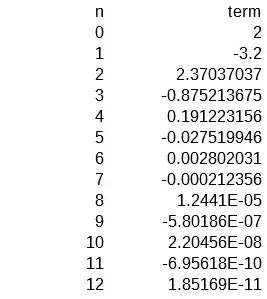You want to solve for $n$ $$\frac{x^{4n+1}}{(4n+1)(2n)!}\leq \epsilon \tag 1$$ The lhs can be approximated by
$$\frac{x^{4n+1}}{(4n+1)(2n)!}\sim\frac{x^{4n+1}}{2(2n+1)(2n)!}=\frac 1{2x} \frac {(x^2)^{2n+1}}{(2n+1)!}$$ So, we need to solve for $n$
$$(2n+1)!=\frac {(x^2)^{2n+1}}{2x\epsilon}$$ For the time being, let $m=2n+1$, $x^2=a$ and $2x \epsilon=10^{-k}$ to make
$$m!=a^m 10^k$$
If you look at this question of mine, you will see a magnificent approximation built by @robjohn for this last equation.
$$
m\sim ea\exp\left(\operatorname{W}\left(\frac k{ea}\log(10)-\frac1{2ea}\log(2\pi a)\right)\right)-\frac12$$ where appears Lambert function.
Applied to your case, this would give
$$2n+1=e x^2\exp\left(W\left(-\frac{\log \left(8 \pi x^4 \epsilon ^2\right)}{2 e x^2}\right)\right)-\frac12\tag 2$$
Now, let $\epsilon=10^{-p}$ and $x=2$ as Ross Millikan used for the test and you will get for $n$ the approximation given by $(2)$ as well as the exact solution of $(1)$
$$\left(
\begin{array}{ccc}
p & \text{approximation} & \text{solution} \\
1 & 4.32647 & 4.32867 \\
2 & 5.44001 & 5.44150 \\
3 & 6.39673 & 6.39788 \\
4 & 7.26127 & 7.26220 \\
5 & 8.06292 & 8.06372 \\
6 & 8.81800 & 8.81869 \\
7 & 9.53669 & 9.53731 \\
8 & 10.2259 & 10.2264 \\
9 & 10.8905 & 10.8910 \\
10 & 11.5342 & 11.5347 \\
11 & 12.1599 & 12.1603 \\
12 & 12.7696 & 12.7700
\end{array}
\right)$$
and you need to use $\lceil n \rceil$.
Edit
The results are quite sensitive to the value of $x$. Using $x=3$, we should get for $n$
$$\left(
\begin{array}{ccc}
p & \text{approximation} & \text{solution} \\
1 & 10.7036 & 10.7166 \\
2 & 11.8740 & 11.8847 \\
3 & 12.9471 & 12.9562 \\
4 & 13.9492 & 13.9572 \\
5 & 14.8966 & 14.9037 \\
6 & 15.7999 & 15.8063 \\
7 & 16.6668 & 16.6727 \\
8 & 17.5029 & 17.5083 \\
9 & 18.3125 & 18.3175 \\
10 & 19.0989 & 19.1036 \\
11 & 19.8648 & 19.8692 \\
12 & 20.6125 & 20.6166
\end{array}
\right)$$
